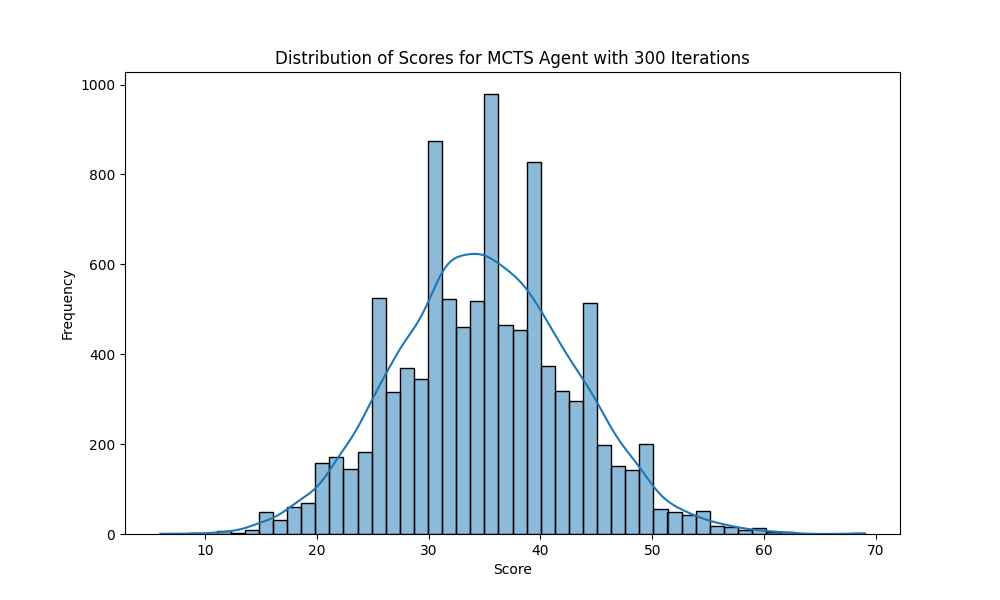
AI agents take on the challenge of mastering the strategic board game Calico, combining creative gameplay with advanced algorithms like Monte Carlo Tree Search and Deep Q-Networks. Through competitive analysis, this project reveals how AI adapts to complex decision-making scenarios.
Skills Used:
Python programming for game logic and AI implementation.
AI techniques: Monte Carlo Tree Search, Deep Q-Networks, and greedy algorithms.
Data structures and algorithms (graph representation, DFS for grouping tiles).
Machine learning model training using PyTorch.
Problem-solving and critical analysis of AI strategies.
Software testing methodologies (unit, integration, manual).
Data visualization for results using Matplotlib and Seaborn.
Technical Specification
Python
PyTorch
NumPy
Matplotlib
Seaborn
Pandas
Training Environment: Windows with i7-9750H processor, NVIDIA RTX 2060 GPU, 16GB RAM.
Features Implemented
Digital implementation of the board game Calico with accurate mechanics.
Implemented functional AI agents to play the game: Random, Greedy, Monte Carlo Tree Search, and Deep Q-Netowrk.
Scoring algorithms for design tiles, buttons, and cat tokens.
Game state management including board setup, player turns, and game-end conditions.
Data visualization for game and results.
Comprehensive testing (unit, integration, and manual) for game and AI agents.
Performance evaluation of AI agents in solo and head-to-head matches.
Planning and Design
The project began with a detailed analysis of the board game Calico to understand its rules, mechanics, and strategic complexities. The planning phase focused on breaking the project into two main parts: implementing the digital version of the game and designing AI agents to play it. A hybrid approach to data structures was chosen, combining a graph representation for the board with an array for efficient access, ensuring both code clarity and runtime efficiency. Detailed requirements for functionality and performance were outlined to guide the development process.
The design phase involved creating a robust architecture for the game, using class diagrams to structure components like the board, tiles, and scoring systems. AI agent designs were carefully planned to reflect varying levels of strategic depth, from simple random and greedy approaches to more sophisticated Monte Carlo Tree Search (MCTS) and Deep Q-Networks (DQN). Each design was tailored to ensure modularity, scalability, and compatibility with the game logic, allowing for seamless integration and testing throughout development.
Challenges & Lessons Learned
State Space Complexity: Handling the vast state space of Calico was a significant challenge, requiring innovative approaches like Monte Carlo Tree Search to explore the game's possibilities effectively. This highlighted the importance of balancing computational efficiency with strategic depth.
Diverse AI Strategies: Designing AI agents with varying levels of sophistication, from simple random decisions to Deep Q-Networks, required overcoming challenges in implementing and fine-tuning algorithms to align with the game’s unique mechanics. This process emphasized the need for iterative development and rigorous testing.
Game Balance Analysis: Evaluating the balance of the game using AI agents revealed complexities in quantifying fairness and strategy effectiveness. This taught the importance of combining quantitative metrics with qualitative observations for meaningful insights.
Resource Constraints: Training the Deep Q-Network agent demanded significant computational resources and fine-tuning to achieve consistent performance, underscoring the value of hardware optimization and efficient neural network design.
Conclusion
The project successfully brought the board game Calico to life in a digital environment and demonstrated the potential of AI to tackle complex, non-deterministic games. By implementing and analyzing diverse AI strategies, from Monte Carlo Tree Search to Deep Q-Networks, it highlighted the strengths and limitations of various approaches in decision-making scenarios. Beyond gameplay, the project offered valuable insights into game balance and AI adaptability, showcasing the broader applications of these techniques in real-world problem-solving.






